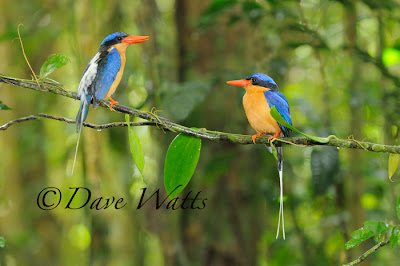It takes several days to drive north from
Melbourne to North Queensland for a distance of over 1,700 miles! Yes it is a
big country.
North Queensland has much to offer the
naturalist and wildlife photographer due to the incredibly rich areas of
tropical rainforest which in some parts occur down to sea level. The remaining
areas of rainforest are now protected by a system of World Heritage National
Parks which have one of the richest variety of plant and animal life found
anywhere on Earth.
For a wildlife photographer the rainforest
comes with a particular set of problems. Firstly during the spring and summer
it certainly knows how to rain. Combine that with extremely low light levels
found under the rainforest canopy and photography of many of the unique
creatures becomes quite difficult.
Where else can you find the giant Southern
Cassowary, Regent Bowerbird, the stunning Buff-breasted Paradise Kingfisher,
together with Lumholtz’s Tree Kangaroo and the most primitive Musky Rat
Kangaroo.
 |
Male Southern Cassowary and three chicks
Nikon D300S plus Nikkor 70 – 200mm F2.89
AFS-VR
ISO 1000, 1/80 SEC @ F6.3
Nikon SB800 fill flash @ -1.3 stops
|
We initially spent several days searching
patches of rainforest for Southern Cassowaries until we saw our first, an adult
male which trotted past us as it gobbled up fallen rainforest fruit. Over the
next few weeks we encountered several of the giant flightless birds including a
male with young stripy chicks.
 |
Female Southern Cassowary shaking feathers
Nikon D300S plus Nikkor 70 – 200mm F2.8
AFS-VRVR
ISO 640, 1/500 sec F5.0
Nikon SB800 fill flash @ -1.3 stops
|
Unfortunately these spectacular birds are
threatened by destruction of their rainforest habitat although it is reassuring
to note that they do now have many friends who are aware and committed to their
plight and are working on various rainforest rehabilitation schemes.
We were extremely keen to make contact with
one of North Queensland’s most beautiful birds, the Buff-breasted Paradise
Kingfisher. This spectacular bird is a summer breeding visitor which doesn’t
arrive at its rainforest breeding grounds until late November/December – the
wet season. It was soon apparent that this season was going to be even wetter
than usual.
Buff-breasted Paradise Kingfishers excavate
tunnels in active termite mounds so we set up our hide overlooking a recently
arrived pair with their chosen mound. The light under the rainforest canopy was
dimmer than dim and it rained incessantly. It was also impossible to keep the
clouds of mosquitoes out of my dome hide. I needed to set up several Nikon
speedlights, each covered in a plastic bag. A vital requirement under these
conditions. Once again the wireless speedlights performed flawlessly. However
it was a joy to watch these oh so special birds digging out their breeding
chamber and displaying over the termite mound.
 |
Buff-breasted Paradise Kingfisher flying
from termite mound
Nikon D300S plus Nikkor 70 – 200mm F2.8
AFS-VR
ISO 2500, 1/250 sec, F14
3 Nikon Speedlights set to wireless. Tripod
plus dome hide
|
North Queensland also has a huge assemblage
of mammals, mainly marsupial but also many species of rats and mice. Lumholtz’s
Tree Kangaroo occurs here but again it is very difficult to locate being
largely nocturnal and spending most of its time in the rainforest canopy.
 |
Male Lumholtz Tree Kangaroo
Nikon D300S plus Nikkor 70 – 200mm F2.8
AFS-VR
ISO 640, 1/23 @ F4
Nikon SB800 fill flash @-1.3 stops
|
More than anything what is required to
capture images of these cryptic creatures is time, and lots of it. We spent
over 2 weeks searching for Southern Cassowaries. However at times you may get
lucky as late one afternoon my wife Helen sent a radio message to say she had
found a Green Ringtail Possum asleep on a low branch – with a joey in its
pouch.
 |
Green Ringtail Possum with baby in pouch
Nikon D300S plus Nikkor 70 – 200mm F2.8
AFS-VR
ISO 1000, 1/30 sec @F3.5
Nikon SB800 Fill flash @ -1.3 stops
|
Heading slightly west we reached drier
country and here we discovered some superb specimens of Frilled Lizard which in
Queensland have a much more yellow frill compared to the redder frill of the
individuals from the Northern Territory.
 |
Frilled Lizard
Nikon D300S plus Nikkor 70 – 200mm F2.8
AFS-VR
ISO 400 1/400 sec @ F8
Nikon SB800 Fill flash @ -1.3 stops
|
It was now mid December and a tropical
cyclone was heading towards the coast. We needed to head south in a hurry but
much of Queensland and New South Wales were covered in floodwaters. In fact the
flooded area covered a region greater than western Europe. We were trapped
several times by flooded roads but eventually were fortunate to make Victoria
for Christmas.

